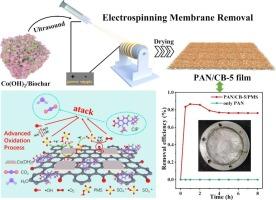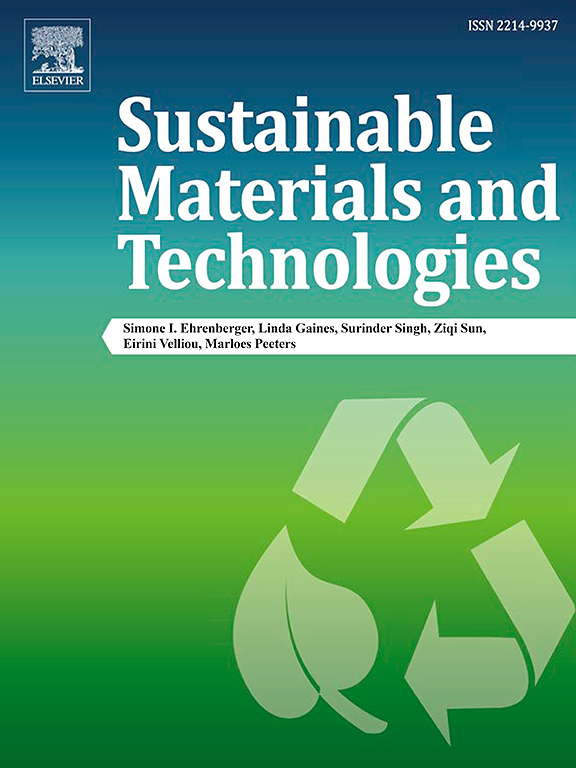Biochar-supported Co(OH)2 nanosheets activated persulfate: Enhanced removal of ciprofloxacin and membrane purification
IF 9.2
2区 工程技术
Q1 ENERGY & FUELS
引用次数: 0
Abstract
Developing sophisticated composite based on biochar sheds light on the breakdown of antibiotics during wastewater treatment. In this work, the new cobalt species supported on wheat biochar catalyst (Co(OH)2/biochar) nanofibers were created via a hydrothermal-electrospinning technique. A set of analyses revealed that the biochar's surface was covered by amorphous Co(OH)2 nanosheets, which had a greater capacity to activate peroxymonosulfate (PMS) and break down ciprofloxacin (CIP) compared to Co(OH)2. Specifically, the Co(OH)2/biochar/PMS system achieved 1.30 min−1 degradation rates, which is greater than pristine biochar and Co(OH)2, and the excellent PMS activation was attributed to more exposing surface Co ions and faster Co2+/Co3+ cycling. Moreover, capture experiments and X-ray Photoelectron Spectrum (XPS) of the used catalyst further confirmed that the large amount of 1O2 produced in this system stems from the synergy between the activation of PMS by Co2+ and C![]() O of biochar. Subsequently, a self-made wastewater nanofiber purification reactor was built to drive CIP removal, and the Co(OH)2/biochar nanofiber maintained superior removal efficiency with continuous operation (8 h). Finally, the degradation pathway and toxicity estimation were further investigated. In all, this work provides a new nanofiber purification approach for the effective treatment of refractory antibiotics.
O of biochar. Subsequently, a self-made wastewater nanofiber purification reactor was built to drive CIP removal, and the Co(OH)2/biochar nanofiber maintained superior removal efficiency with continuous operation (8 h). Finally, the degradation pathway and toxicity estimation were further investigated. In all, this work provides a new nanofiber purification approach for the effective treatment of refractory antibiotics.

生物炭支撑的Co(OH)2纳米片活化过硫酸盐:增强环丙沙星的去除和膜纯化
开发基于生物炭的复杂复合材料有助于了解废水处理过程中抗生素的分解情况。在这项工作中,通过水热-电纺丝技术在小麦生物炭催化剂(Co(OH)2/生物炭)上制备出了新的钴物种纳米纤维。一系列分析表明,生物炭表面覆盖着无定形的 Co(OH)2 纳米片,与 Co(OH)2 相比,无定形的 Co(OH)2 纳米片具有更强的活化过一硫酸盐(PMS)和分解环丙沙星(CIP)的能力。具体而言,Co(OH)2/生物炭/PMS 系统的降解率达到 1.30 min-1,高于原始生物炭和 Co(OH)2,而 PMS 的出色活化能力归因于更多的表面 Co 离子暴露和更快的 Co2+/Co3+ 循环。此外,所使用催化剂的捕获实验和 X 射线光电子能谱(XPS)进一步证实,该体系中产生的大量 1O2 源自 Co2+ 对 PMS 的活化和生物炭的 CO 的协同作用。随后,自制了一个废水纳米纤维净化反应器来驱动 CIP 的去除,Co(OH)2/生物炭纳米纤维在连续运行(8 h)的情况下保持了优异的去除效率。最后,进一步研究了降解途径和毒性评估。总之,这项工作为有效处理难治性抗生素提供了一种新的纳米纤维净化方法。
本文章由计算机程序翻译,如有差异,请以英文原文为准。
求助全文
约1分钟内获得全文
求助全文
来源期刊

Sustainable Materials and Technologies
Energy-Renewable Energy, Sustainability and the Environment
CiteScore
13.40
自引率
4.20%
发文量
158
审稿时长
45 days
期刊介绍:
Sustainable Materials and Technologies (SM&T), an international, cross-disciplinary, fully open access journal published by Elsevier, focuses on original full-length research articles and reviews. It covers applied or fundamental science of nano-, micro-, meso-, and macro-scale aspects of materials and technologies for sustainable development. SM&T gives special attention to contributions that bridge the knowledge gap between materials and system designs.
 求助内容:
求助内容: 应助结果提醒方式:
应助结果提醒方式:


